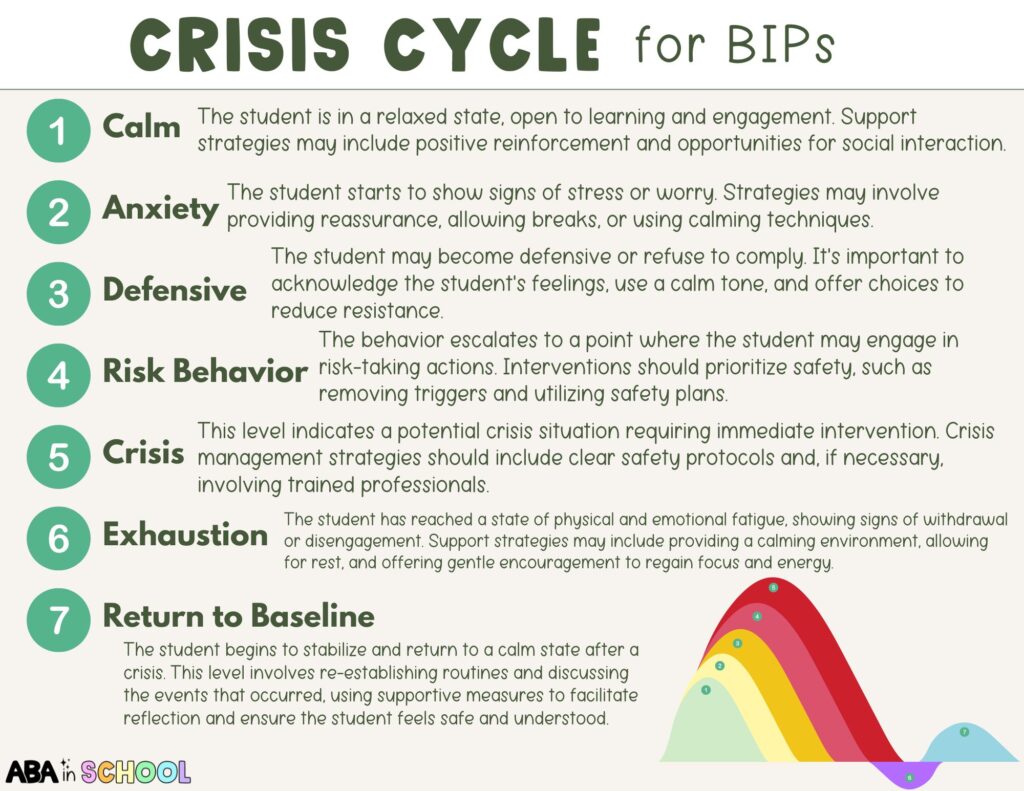In every special education classroom, challenging behaviors are inevitable, but not all behaviors lead to a crisis. Sometimes, these behaviors are what we call “one-and-done” moments—like a student calling out in frustration or pushing a friend off the swing in a single instance. However, for more significant and extended behaviors, the Crisis Cycle provides a framework to help special education teachers and BCBAs understand, manage, and de-escalate these situations effectively.
The Crisis Cycle, which follows a 7-stage process, helps us recognize the phases of escalation and offers strategies to support students through each stage. It’s essential to remember that while some students may appear to go from 0 to 100 in a second, subtle cues often indicate stress before the behavior peaks. Recognizing these pre-crisis behaviors can help prevent a full escalation.
Let’s walk through each stage of the crisis cycle, see what it might look like and find practical, trauma-informed strategies to support students.
At the beginning of the cycle, the learner is in a calm state, where they are receptive to learning and social interactions. This is the ideal time to reinforce positive behaviors and build connections. During this stage, the learner is engaged, relaxed, and open to instruction.
What it looks like:
Strategies:
As the learner begins to feel anxious or stressed, you may notice subtle changes in their behavior. This is the stage where their frustration starts to build, even if they aren’t outwardly disruptive yet. The key here is recognizing these early signs before they escalate further.
What it looks like:
Strategies:
When the learner reaches the defensive stage, they may start to resist or challenge directions. This stage is critical because the behavior can escalate quickly if not handled effectively. It’s important to remember that a defensive learner is responding to stress and trying to protect themselves, even if it seems like defiance.
What it looks like:
Strategies:
At this point, the learner’s behavior escalates to the risk behavior stage. This could involve actions that put themselves or others at risk, whether through verbal threats or physical actions. Safety becomes the priority.
What it looks like:
Strategies:
The crisis stage represents the peak of the behavior. At this point, the learner is unable to process information or make rational decisions. Your role is to remain calm, protect safety, and wait for the escalation to de-escalate.
What it looks like:
Strategies:
6. Exhaustion
Following the peak of the crisis, the learner will often experience a state of exhaustion. They may appear withdrawn or physically fatigued. This is the body’s way of recovering from the intense emotional and physical energy spent during the crisis.
What it looks like:
Strategies:
7. Return to Baseline
As the learner begins to stabilize, they will enter the return to baseline stage. This is where you help them re-establish routines and reflect on the incident in a supportive, non-punitive way.
What it looks like:
Strategies:

Ensuring Safety and Seeking Support during Crisis Cycle
The ultimate goal throughout the crisis cycle is to maintain, regain, and ensure safety for both the student and the staff. If you feel overwhelmed or unsure of how to manage a crisis, don’t hesitate to reach out to your administration or behavior support team for help. No one should handle these situations with crisis cycle alone.
Remember, supporting students through a crisis is not about preventing all behaviors, but about navigating them with patience, understanding, and a focus on trauma-informed care. Each day is a new opportunity to start fresh, ensuring that students feel safe, supported, and understood.
Read more about the crisis cycle and behavior:
Article to Support Crisis Cycle
What are you looking for?
COPYRIGHT © 2025 Full SPED Ahead